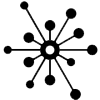The answer to why illusions work is a long one. Different images create illusions for different reasons, or multiple reasons. Here are some explanations with examples.

Many illusions work by tricking our brains into seeing things that aren't there. That can happen because as humans, we have evolved to seek out shapes in complicated scenery (think lion in a bush). Our pattern-loving brains do this effortlessly. We see faces on the moon, figures in shadows, and eyes in the glimmers of the night. Although the average person no longer has predators to worry about, this neural pathway remains. The temporal lobe plays in important role in assigning meaning to what we see, contributing to this effect.

Another way illusions work is through altering perception. Although our consious perception appears to be complete and fluid, that itself is an illusion created by the brain. When our eyes dart around or our focus changes, gaps in visual stimulus occur. The frontal, parietal, temporal, and occipital lobes all help recognize these gaps and fill them in to create what we perceive as vision. Through careful image manipulation of unnatural scenes, we can severely confuse this system.

A third type of illusion comes not from tricking our minds, but from confusing our thoughts. These are illusions that are usually simple yet don't make any cognitive sense. These images are only confusing when we try to rationalize and conceptualize what's being depicted.







